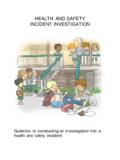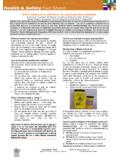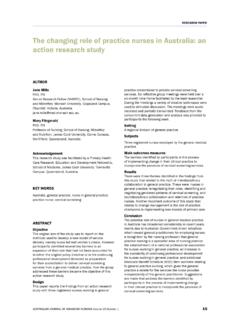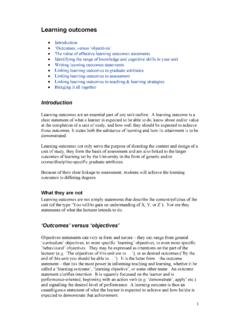Transcription of Review of educational research - Education …
1 Of educational online version of this article can be found at: DOI: 2007 77: 81 Review OF educational RESEARCHJohn Hattie and Helen TimperleyThe Power of feedback Published on behalf of American educational research Associationand can be found at: Review of educational ResearchAdditional services and information for Alerts: : : : by guest on January 30, 2011 from 81 Review of educational ResearchMarch 2007, Vol. 77, No. 1, pp. 81 112 DOI: Power of FeedbackJohn Hattie and Helen TimperleyUniversity of AucklandFeedback is one of the most powerful influences on learning and achieve-ment, but this impact can be either positive or negative. Its power is fre-quently mentioned in articles about learning and teaching, but surprisinglyfew recent studies have systematically investigated its meaning.
2 This articleprovides a conceptual analysis of feedback and reviews the evidence relatedto its impact on learning and achievement. This evidence shows that althoughfeedback is among the major influences, the type of feedback and the way itis given can be differentially effective. A model of feedback is then proposedthat identifies the particular properties and circumstances that make it effec-tive, and some typically thorny issues are discussed, including the timing offeedback and the effects of positive and negative feedback . Finally, this analy-sis is used to suggest ways in which feedback can be used to enhance its effec-tiveness in : feedback , assessment, student and teacher it is often mentioned in articles about learning and teaching, surpris-ingly few recent studies have systematically investigated the meaning of feedbackin classrooms.
3 In this article, we begin with a conceptual analysis of the meaningof feedback and a synthesis of the evidence related to the power of feedback toimprove teaching and learning. We then propose a model of feedback that is usedto identify the circumstances under which feedback has the greatest , the research evidence related to the different types of feedback andtheir effectiveness in terms of promoting student learning are discussed, the dif-ferent ways students deal with feedback are described, and the relationshipbetween assessment and feedback is provided. Finally, the model, together withthe evidence underpinning it, is used to show how feedback can be used to enhanceclassroom learning and Meaning of FeedbackIn this Review , feedback is conceptualized as information provided by an agent( , teacher, peer, book, parent, self, experience) regarding aspects of one s per-formance or understanding.
4 A teacher or parent can provide corrective informa-tion, a peer can provide an alternative strategy, a book can provide information toclarify ideas, a parent can provide encouragement, and a learner can look up theanswer to evaluate the correctness of a response. feedback thus is a consequence of performance. by guest on January 30, 2011 from Hattie & Timperley82To assist in understanding the purpose, effects, and types of feedback , it is use-ful to consider a continuum of instruction and feedback . At one end of the contin-uum is a clear distinction between providing instruction and providing , when feedback is combined with more a correctional Review , the feed-back and instruction become intertwined until the process itself takes on the formsof new instruction, rather than informing the student solely about correctness (Kulhavy, 1977, p.)
5 212). To take on this instructional purpose, feedback needs toprovide information specifically relating to the task or process of learning that fillsa gap between what is understood and what is aimed to be understood (Sadler,1989), and it can do this in a number of different ways. These may be through affec-tive processes, such as increased effort, motivation, or engagement. Alternatively,the gap may be reduced through a number of different cognitive processes, includ-ing restructuring understandings, confirming to students that they are correct orincorrect, indicating that more information is available or needed, pointing to direc-tions students could pursue, and/or indicating alternative strategies to understandparticular information.
6 Winne and Butler (1994) provided an excellent summary intheir claim that feedback is information with which a learner can confirm, add to,overwrite, tune, or restructure information in memory, whether that information isdomain knowledge, meta-cognitive knowledge, beliefs about self and tasks, or cog-nitive tactics and strategies (p. 5740). feedback has no effect in a vacuum; to be powerful in its effect, there must be alearning context to which feedback is addressed. It is but part of the teaching processand is that which happens second after a student has responded to initial instruc-tion when information is provided regarding some aspect(s) of the student s taskperformance. It is most powerful when it addresses faulty interpretations, not a totallack of understanding.
7 Under the latter circumstance, it may even be threatening toa student: If the material studied is unfamiliar or abstruse, providing feedbackshould have little effect on criterion performance, since there is no way to relate thenew information to what is already known (Kulhavy, 1977, p. 220).The focus of this article on feedback as information about the content and/orunderstanding of the constructions that students have made from the learning expe-rience is not the same as a behaviorist input-output model. Contrary to the behav-iorists argument, Kulhavy (1977) demonstrated that feedback is not necessarily areinforcer, because feedback can be accepted, modified, or rejected. feedback byitself may not have the power to initiate further action.
8 In addition, it is the casethat feedback is not only given by teachers, students, peers, and so on, but can alsobe sought by students, peers, and so on, and detected by a learner without it beingintentionally Effectiveness of FeedbackThe first question to ask is, How effective is feedback ? We answer this ques-tion by referring to the usual effects of schooling on student achievement and thencomparing them with the evidence related to feedback . Hattie (1999) reported asynthesis of over 500 meta-analyses, involving 450,000 effect sizes from 180,000studies, representing approximately 20 to 30 million students, on various influ-ences on student achievement. This analysis included more than 100 factors influ-encing educational achievement and covered various aspects of those typically by guest on January 30, 2011 from 83identified, such as attributes of schools, homes, students, teachers, and average or typical effect of schooling was (SE= ), and this provideda benchmark figure or standard from which to judge the various influences onachievement, such as that of least 12 previous meta-analyses have included specific information on feed-back in classrooms (Table 1).
9 These meta-analyses included 196 studies and 6,972effect sizes. The average effect size was (twice the average effect). To placethis average of into perspective, it fell in the top 5 to 10 highest influences onachievement in Hattie s (1999) synthesis, along with direct instruction ( ), rec-iprocal teaching ( ), students prior cognitive ability ( ), and also can be con-trasted with other influences such as acceleration ( ), socioeconomic influences( ), homework ( ), the use of calculators ( ), reducing class size ( ),and retention back 1 year ( ). Clearly, feedback can be effect sizes reported in the feedback meta-analyses, however, show con-siderable variability, indicating that some types of feedback are more powerfulTABLE 1 Summary of effect sizes from 12 meta-analyses assessing the influences of feedbackNumber of EffectStudyContexteffectssizeSkiba, Casey, and For special Education Center (1985-1986) and Walberg (1982)Cues, corrective (1982)Cues, motivational influences, and and Cues, participation,Goldring (1989)reinforcement, feedback , and and Feinberg (1988)Extrinsic feedback and Miller (1983)Diagnostic feedback in and DeNisi (1996) Hommedieu, Menges, and Brinko (1990)From student (1986) , Kulik, Kulik, and Morgan (1991)From and Kulik (1988)
10 Immediate versus , Langer, and Glass (1985)Rewards and (1981)Teacher by guest on January 30, 2011 from 84than others. Those studies showing the highest effect sizes involved studentsreceiving information feedback about a task and how to do it more effect sizes were related to praise, rewards, and more detailed synthesis of 74 meta-analyses in Hattie s (1999) database thatincluded some information about feedback (across more than 7,000 studies and13,370 effect sizes, including those in Table 2) demonstrated that the most effec-tive forms of feedback provide cues or reinforcement to learners; are in the formof video-, audio-, or computer-assisted instructional feedback ; and/or relate togoals. Programmed instruction, praise, punishment, and extrinsic rewards were theleast effective for enhancing achievement (Table 3).













